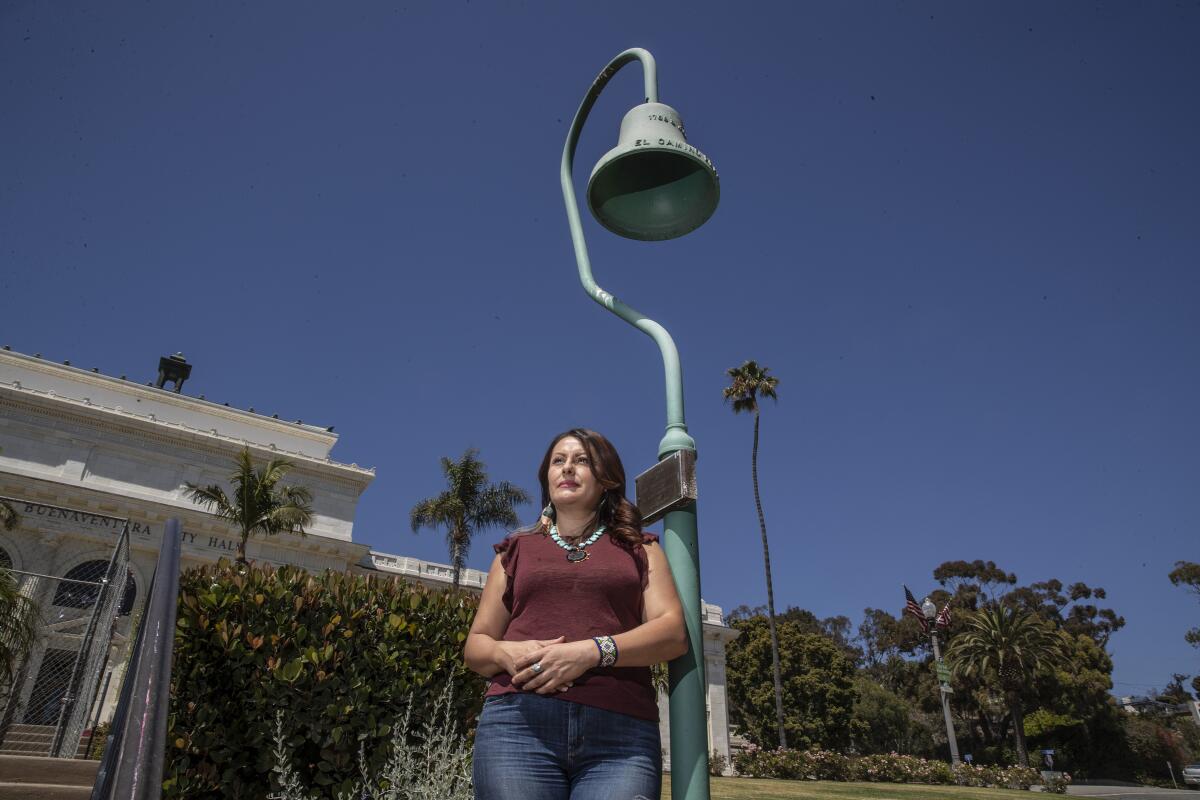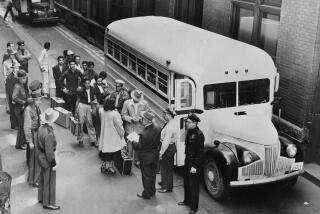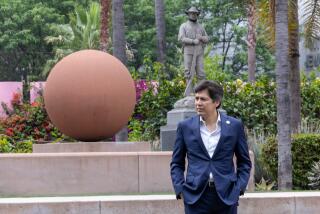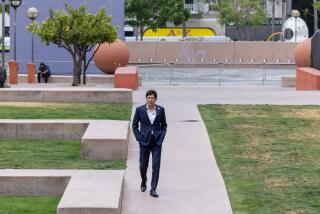‘Agent of colonialism’ or a ‘saint for our times’? Junipero Serra’s legacy divides Latinos

- Share via
VENTURA — He was the architect of California’s Roman Catholic missions, a man taught to generations of schoolchildren as a founding father of the Golden State and the first-ever Hispanic saint from the United States. Father Junípero Serra’s arrival in California in 1769 also marked the beginning of centuries of exploitation and decimation for Native Californians, the very people Serra vowed to “save” with Christianity.
Now, as statues of Confederate generals fall and the legacies of Christopher Columbus, John Muir and Woodrow Wilson are being questioned, Serra has suddenly become a flashpoint for addressing the wrongs of history.
Latinos have long struggled with how to assess the legacy of Serra, a man whom many of the faithful still hold in the highest regard even as a younger generation cannot understand how people can look past the darkness of the world he helped create. But that debate has intensified in recent months.
Chicano and Indigenous activists ripped down statues of him in Los Angeles, Sacramento and San Francisco, while Ventura’s City Council agreed last month to relocate bronze and wooden monuments away from public property.
The San Gabriel and San Luis Obispo missions moved their effigies away from public viewing for fear of desecration. On June 26, a cross dedicated to Serra located on Mt. Rubidoux, in Riverside County, was also vandalized.
Tensions have also risen in San Gabriel after a fire broke out July 11 at the mission, moved to the city in 1775, that destroyed the roof and most pews. Arson is at least one of a few potential causes being investigated. There has been no update on the ongoing investigation since July 22.
What has transpired over the last few months has devastated 39-year-old Ventura resident Gabriel Enriquez. The Santa Paula High School social science teacher believes there is a war against Catholicism and Spanish-speaking communities.
Enriquez attended four virtual public forums in the run up to a 6-0 vote by the Ventura City Council to remove two Serra statues from or nearby City Hall on July 15, the feast day of St. Bonaventure, the patron saint of Ventura’s Mission Basilica San Buenaventura, one of nine missions founded by Serra.
Over 100 speakers excoriated or defended Serra that night. Some said he protected Indigenous peoples and his sainthood made him beyond reproach. Others accused him of genocide, of creating concentration camps, and likened him to Hitler.
“When I started to listen to the public comments, you can just hear the anti-Catholic strain in those comments,” he said. “What I didn’t hear was experts talking about the truth of Father Serra. Bring them in and then let’s have a real discussion.”
But another Ventura resident, Veronica Valadez, felt that any conversation about the Franciscan priest was long over.
“People speak of Father Serra’s contributions, but oftentimes no one asks who his contributions benefited,” said the 46-year-old Chicano Studies lecturer at Cal State Channel Islands.
Valadez was dressed in the full Aztec regalia she would wear once a month in the pre-pandemic days as part of a dance troupe.
“His contributions benefited the Spaniards, the Europeans, the colonial system and a racial caste system that placed Europeans and white men at the top while placing Indigenous people, who were the original caretakers of these lands, at the bottom,” she said.
“So no,” she concluded, “I do not consider Father Serra a great man.”
The Franciscan priest championed a Native bill of rights and became the first Hispanic saint to have lived in what’s now the United States when Pope Francis canonized Serra in 2015. But Serra was also part of a Spanish conquest that brought disease, death and harsh punishment to Indigenous populations, while confiscating their lands and pushing for assimilation.
In his day, Serra was not well-liked or understood by his own countrymen.
“He wasn’t a relatable character in the late 18th century,” said Bay Area native Ashley Riley Sousa, an associate professor of history at Middle Tennessee State University. “He was a fanatic and he may sound good in some history books, but this is a man who refused medical treatment, who beat himself with chains and whose goal was to be martyred in California. He was out there.”

In 2015, California Insurance Commissioner and East L.A native Ricardo Lara, 45, made a strong but ultimately unsuccessful push as a state senator to swap a Serra statue at the United States Capitol Building with one of pioneering astronaut Sally Ride.
“This is the power of representation, to have a woman and member of the LGBTQ+ community representing California would have been a big step,” Lara said. “But instead, we’re left with Father Serra.”
While Lara understands Serra was a poor, Spanish-speaking priest who lived and died in California — a figure Latinos can easily connect with — he believes the community should cut ties.
“Hey, put up a statue of Cesar Chavez or Dolores Huerta,” Lara said. “We have plenty of heroes. We don’t need someone who erased Native cultures.”
“Serra wanted Native societies to transform from one of hunter-gathers to agriculturalists. Well, you do that by destroying their lifestyle, their plants, their animals, their way of living, their values and their culture.”
— Jim Sandos, a professor emeritus of history at the University of Redlands
Jim Sandos, a professor emeritus of history at the University of Redlands who has published 20 articles and books on the California mission system, said there was hyperbole on both sides.
“There were high rates of deaths in the mission, but not a genocide,” Sandos said. “This is a phrase that is repeated often and it started in the 1960s when Native populations tried to reclaim their history and push back at the idea that everyone was happy and harmonious at the missions.”
On the other hand, Sandos referred to Serra as “an agent of colonialism” and a key leader of a conquest, “actual and spiritual,” of Indigenous people. The spread of Catholicism and the “salvation of souls,” contends Sandos, came at a high cost.
“Serra wanted Native societies to transform from one of hunter-gathers to agriculturalists,” he said. “Well, you do that by destroying their lifestyle, their plants, their animals, their way of living, their values and their culture.”
Sousa credits his rise from obscurity in Alta California, which she called the “Siberia of the Spanish and Mexican empires,” because of its distance and perception as inhospitable, to California icon thanks to white settlement.
As Anglos began to settle the state in the mid-19th century and into the 20th century, the mission system provided them with a link to a glorious “if not mythic European” and white past that ignored Native culture and converted Serra from ordinary priest into founding father.
“California was no longer some dusty Mexican backwater,” Sousa said.
The drive to revitalize the missions from the 1880s to the 1920s and even beyond included the rehabilitation of Serra’s image, the building of monuments, statues and the crafting of a pro-Serra and pro-mission history that continues to this day, contends Sousa, and the erasure of any kind of white European shame.
Lehigh University sociology professor Hugo Ceron-Anaya believes some Latinos latch onto Serra precisely because of this Europeanness.
“Europe and European culture has been at the top for centuries that many Latinos identify their roots going back to Spain and erase much of their native identity and culture,” he said. “We like to say we’re mestizos (part Spanish, part Indigenous), but how much do we celebrate the Indigenous part? There are many Serra statues in California. Now, show me the Indigenous ones?”
Los Angeles Archbishop José Gomez, born in Monterrey, Mexico, and appointed to his current post in 2011, tried to strike a balance between Serra the sinner and Serra the saint in a letter to Catholics in late June.
“I have come to understand how the image of Father Serra and the missions evoke painful memories for some people,” he wrote. “For that reason, I believe the protests over our history in California, and the broader protests that have started elsewhere in the country over historical monuments, are important.”
The archbishop expressed his dismay, however, with elected officials, writing they “cannot abdicate their responsibilities” and allow protesters to vandalize memorials.
Still, Gomez believes Serra “is a saint for our times, the spiritual founder of Los Angeles [and] a champion of human rights.”
Although Gomez’s letter may have aimed for unity and understanding, it arguably just widened the divide.
“What more do you need to hear?” said Rudy Najar, 51, who grew up near the San Gabriel Mission.
The Montclair resident would drive from his home every Sunday to Palmdale and watch online Mass with his mother for the last five years of her life.
“The guy is a saint, people pray to him, he did his best for the Native people and they loved him,” he said. “This is about people hundreds of years later looking to judge him.”
Valadez isn’t surprised some Latinos rushed to Serra’s defense, attributing it to “cognitive dissonance.”
“We’re told Serra is our hero because he was poor, he was a Spanish speaker and Catholic, but he was also part of a mission system that caused so much harm to the Indigenous peoples of California,” she said. “If you choose to embrace him as a Latino, you are also denying something important, and that’s your Indigenous roots.”
More to Read
Sign up for Essential California
The most important California stories and recommendations in your inbox every morning.
You may occasionally receive promotional content from the Los Angeles Times.











